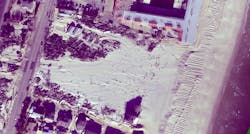Taking a Closer Look at Hurricane Sandy’s Destruction
When Hurricane Sandy battered the East Coast last fall, it was easy to see the result of the destruction: homes were damaged, portions of beach towns were swept away, millions lost power, water surged into New York City’s subways and more. But now, researchers are aiming to give rescue and recovery workers an even clearer picture of the storm damage – the kind of picture that can only be created through satellites, remote-controlled aircraft and infrared/ultraviolet cameras.
A group of Drexel University engineers set out to show emergency workers images of Hurricane Sandy that can’t be seen with the naked eye. They wanted to paint a detailed picture to help these workers respond to the next natural disaster.
“During Hurricane Sandy, 7.5 million power outages were reported and thousands of people were still without power weeks after the hurricane,” said Dr. Anu Pradhan, an assistant professor in Drexel’s College of Engineering and the lead researcher on the National Science Foundation-funded research team. “This is due to the massive destruction, it’s difficult to see the full scope of it by walking through the sites, we need a broader picture that shows the various layers of damage both seen and unseen.”
Infrared (IR) and ultraviolet (UV) imaging technology, combined with acoustic emission (AE) testing can reveal damages to power lines, trees, telephone poles and buildings that appeared to be unscathed. Infrared and ultraviolet cameras can capture radiation that is not visible to the naked eye, while acoustic emission testing uses sound waves to test the elasticity of trees and telephone poles to determine whether they’ve been damaged internally to the point where they could be a falling hazard.
The team already has infrared, ultraviolet and acoustic emission testing equipment at its disposal and has made several visits to storm-damaged areas in New Jersey to take pictures and gather data. It is also in the process of attaching it to a remote controlled aircraft for low-altitude data collection. In addition, the engineers will make a system to display the data on an aerial map of the area and algorithm to help emergency responders triage their recovery efforts.
“In addition to the lives lost and destruction caused by Hurricane Sandy, the residual effects are still very much with us,” said co-researcher Dr. Antonios Kontsos, an assistant professor in the College of Engineering. “Our goal is to make sure that responders have even more information at their disposal the next time something like this happens so that perhaps some of this loss can be prevented.”
About the Author

Laura Walter
Laura Walter was formerly senior editor of EHS Today. She is a subject matter expert in EHS compliance and government issues and has covered a variety of topics relating to occupational safety and health. Her writing has earned awards from the American Society of Business Publication Editors (ASBPE), the Trade Association Business Publications International (TABPI) and APEX Awards for Publication Excellence. Her debut novel, Body of Stars (Dutton) was published in 2021.
